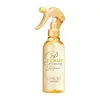Shiseido Tsubaki Premium Repair Hair Water Mist Versus L'Oreal Elvive Hyaluron Plump Moisture Plump Serum
What's inside
What's inside
 Key Ingredients
Key Ingredients

 Benefits
Benefits

 Concerns
Concerns

 Ingredients Side-by-side
Ingredients Side-by-side

Water
Skin ConditioningAlcohol Denat.
AntimicrobialGlycerin
HumectantSodium Lactate
BufferingSteartrimonium Chloride
PreservativeHydroxyethyl Urea
HumectantLactic Acid
BufferingCamellia Seed Oil
Sodium Lauroyl Glutamate
Royal Jelly Extract
Skin ConditioningGlycine Max Seed Extract
Skin ConditioningPPG-20
Skin ConditioningDecyltetradeceth-10
EmulsifyingIsopropyl Alcohol
SolventDisodium EDTA
Ammonium Lactate
BufferingButylene Glycol
HumectantAmodimethicone
Tocopherol
AntioxidantPPG-2-Deceth-12
EmulsifyingMethylparaben
PreservativePhenoxyethanol
PreservativeParfum
MaskingWater, Alcohol Denat., Glycerin, Sodium Lactate, Steartrimonium Chloride, Hydroxyethyl Urea, Lactic Acid, Camellia Seed Oil, Sodium Lauroyl Glutamate, Royal Jelly Extract, Glycine Max Seed Extract, PPG-20, Decyltetradeceth-10, Isopropyl Alcohol, Disodium EDTA, Ammonium Lactate, Butylene Glycol, Amodimethicone, Tocopherol, PPG-2-Deceth-12, Methylparaben, Phenoxyethanol, Parfum
Water
Skin ConditioningPolyquaternium-37
Parfum
MaskingPropylene Glycol Dicaprylate/Dicaprate
EmollientPolysorbate 20
EmulsifyingQuaternium-87
CleansingStearyl Alcohol
EmollientGlycine Soja Oil
EmollientSodium Benzoate
MaskingCaprylyl Glycol
EmollientBehentrimonium Chloride
PreservativePPG-1 Trideceth-6
Skin ConditioningCocos Nucifera Oil
MaskingCandelilla Cera
EmollientPropylene Glycol
HumectantCitric Acid
BufferingIsopropyl Alcohol
SolventSorbitan Oleate
EmulsifyingPentaerythrityl Tetra-Di-T-Butyl Hydroxyhydrocinnamate
AntioxidantPolyquaternium-11
Sodium Hyaluronate
HumectantLimonene
PerfumingCoumarin
PerfumingWater, Polyquaternium-37, Parfum, Propylene Glycol Dicaprylate/Dicaprate, Polysorbate 20, Quaternium-87, Stearyl Alcohol, Glycine Soja Oil, Sodium Benzoate, Caprylyl Glycol, Behentrimonium Chloride, PPG-1 Trideceth-6, Cocos Nucifera Oil, Candelilla Cera, Propylene Glycol, Citric Acid, Isopropyl Alcohol, Sorbitan Oleate, Pentaerythrityl Tetra-Di-T-Butyl Hydroxyhydrocinnamate, Polyquaternium-11, Sodium Hyaluronate, Limonene, Coumarin
 Reviews
Reviews

Ingredients Explained
These ingredients are found in both products.
Ingredients higher up in an ingredient list are typically present in a larger amount.
Isopropyl Alcohol is more commonly known as rubbing alcohol. It is most commonly used as a solvent, meaning it helps other ingredients dissolve.
This ingredient is an astringent alcohol. Astringent alcohols may also irritate skin as they high amounts may strip away your skin's natural oils.
Other types of astringent alcohols include:
According to the National Rosacea Society based in the US, you should be mindful of products with these alcohols in the top half of ingredients.
Any type of sanitizing product will have high amounts of alcohol to help kill bacteria and viruses.
Learn more about Isopropyl AlcoholParfum is a catch-all term for an ingredient or more that is used to give a scent to products.
Also called "fragrance", this ingredient can be a blend of hundreds of chemicals or plant oils. This means every product with "fragrance" or "parfum" in the ingredients list is a different mixture.
For instance, Habanolide is a proprietary trade name for a specific aroma chemical. When used as a fragrance ingredient in cosmetics, most aroma chemicals fall under the broad labeling category of “FRAGRANCE” or “PARFUM” according to EU and US regulations.
The term 'parfum' or 'fragrance' is not regulated in many countries. In many cases, it is up to the brand to define this term.
For instance, many brands choose to label themselves as "fragrance-free" because they are not using synthetic fragrances. However, their products may still contain ingredients such as essential oils that are considered a fragrance by INCI standards.
One example is Calendula flower extract. Calendula is an essential oil that still imparts a scent or 'fragrance'.
Depending on the blend, the ingredients in the mixture can cause allergies and sensitivities on the skin. Some ingredients that are known EU allergens include linalool and citronellol.
Parfum can also be used to mask or cover an unpleasant scent.
The bottom line is: not all fragrances/parfum/ingredients are created equally. If you are worried about fragrances, we recommend taking a closer look at an ingredient. And of course, we always recommend speaking with a professional.
Learn more about ParfumWater. It's the most common cosmetic ingredient of all. You'll usually see it at the top of ingredient lists, meaning that it makes up the largest part of the product.
So why is it so popular? Water most often acts as a solvent - this means that it helps dissolve other ingredients into the formulation.
You'll also recognize water as that liquid we all need to stay alive. If you see this, drink a glass of water. Stay hydrated!
Learn more about Water